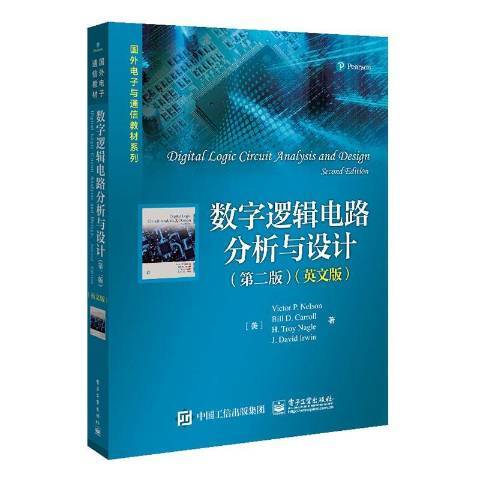《數字邏輯電路分析與設計:英文版》是2020年電子工業出版社出版的圖書。
基本介紹
- 書名:數字邏輯電路分析與設計:英文版
- 作者:(美)Victor P.Nelson//Bill D.Carroll//H.Troy Nagle//J.David Irwin
- 出版社:電子工業出版社
- 出版時間:2020年
- 開本:16 開
- ISBN:9787121398704

《數字邏輯電路分析與設計:英文版》是2020年電子工業出版社出版的圖書。
《數字邏輯電路分析與設計:英文版》是2020年電子工業出版社出版的圖書。內容簡介本書以介紹數字設計的基礎知識以及豐富案例為主要特色,並在*版的基礎上進行了全面的修訂與更新,更加突出了數字設計相關技術的套用。本書內容包括:...
數字邏輯電路分析與設計(第2版)(英文版) 《數字邏輯電路分析與設計(第2版)(英文版)》是2020年電子工業出版社出版的圖書。
《數字邏輯電路分析與設計》是2016年5月清華大學出版社出版的圖書,作者是Victor P· Nelson、H· Troy Nagle、Bill D· Carroll、J· David Irwin。內容簡介 本書是來自三所大學的四位作者通力合作努力的成果結晶。除了經過出版商所贊助的大量業界評論意見外,在本書寫作過程中,書稿在三所大學的各種課程中進行了...
全書包括引論、信息的二進制表達、邏輯代數基礎、邏輯門電路、組合邏輯電路設計、存儲電路、時序邏輯電路設計等共7章。每章內容包含:知識要點、重點、難點和習題。本習題冊題型豐富,難易適中,對鞏固課堂知識、提高學生分析問題和解決問題的能力有較好的幫助。本書提供習題參考答案。圖書內容 《數字邏輯設計及套用習題冊...
主要內容包括半導體器件、運算放大器、電源、電子儀器、線性電路分析、數字邏輯電路、積體電路、數字多媒體系統、電子系統、EDA工具、IC手冊。每個主題單元由課文、閱讀材料、課文辭彙、課文注釋和練習組成。《電子技術專業英語教程》書後附有課文參考譯文、習題參考答案、科技英語寫作要求等內容。為了方便教學,《電子技術...
《數字邏輯電路分析與設計教程》是一本熊小君 馬然 王旭智 薛雷編制,在2012-8-24出版的書籍。圖書簡介 本書以數字邏輯為基礎,全面介紹了數字電路的基本理論、分析方法、綜合方法和實際套用。本書共分8章,第1章介紹數制之間的轉換及常用的編碼; 第2章介紹邏輯代數及邏輯化簡的基本方法; 第3章介紹幾個常用的...
《數字原理與設計》是2006年10月1日清華大學出版社出版的圖書,作者是吉沃恩。內容簡介 這本中英文對照的雙語版教材是以原版的英文教材(DonaldD.Givone的著作DigitalPrinciplesandDesign,2003年由McGrawHill公司出版)為主,附上其中重點章節的漢語譯文。該書詳細、系統地論述了數字系統實現涉及的基本原理和分析設計方法...
第3章 組合邏輯電路 引言 3.1 組合邏輯電路的一般分析與設計 3.1.1 組合邏輯電路的一般分析 3.1.2 組合邏輯電路的設計(用門電路)3.2 常用組合邏輯電路及其中規模集成器件 3.2.1加法器 加法器是產生數的和的裝置。加數和被加數為輸入,和數與進位為輸出的裝置為半加器。若加數、被加數與低位的進位數為...
《數字邏輯電路設計(第二版)》是一本鮑可進、趙念強編寫,由清華大學出版社在2012年出版的書籍。圖書內容 本書從數字電路的基礎知識出發,介紹數制和編碼、邏輯代數、門電路、組合邏輯、時序邏輯、硬體描述語言(VHDL)、可程式器件(PLD、CPLD、HDPLD和FPGA)、在系統編程技術(ISP)及EDA技術的設計思想等內容。用...
《數字邏輯電路設計》是2016年哈爾濱工業大學出版社出版的圖書,作者是張玉茹。內容簡介 “數字邏輯電路設計”是電類專業必修的一門專業基礎課。本書主要介紹數字電路及邏輯設計的基本知識、分析與設計的基本方法及常用集成晶片的使用方法等。全書共分9章,基礎理論部分深入淺出,簡要、透徹;數字邏輯電路的分析與設計部分...
《數字邏輯電路》是2005年科學出版社出版的圖書,作者是連晉平。內容簡介 本書共分為11章和1個附錄,包括:緒論、數制與編碼、邏輯函式及其簡化、集成邏輯門、組合邏輯電路、集成觸發器、時序邏輯電路、半導體存儲器和可程式邏輯器件、脈衝單元電路、模數轉換器和數模轉換器、VHDL語言與數字邏輯電路設計內容。圖書目錄 ...
本書主要分析數字電路。首先討論MOS數字電路分析與設計,重點為CMOS電路,它是構成最流行數字電路的基礎;然後依次介紹基本的數字邏輯門電路、移位暫存器、觸發器和基本的A/D與D/A轉換電路;最後介紹雙極性數字電路,包括射極耦合邏輯電路和傳統的電晶體邏輯(TTL)電路。本書理論聯繫實際,有利於提高讀者的...
《數字電路邏輯設計》是2021年人民郵電出版社出版的圖書。內容簡介 本書系統介紹了數字電路邏輯設計的基本知識、基本理論、基本器件和基本方法,詳細討論了各種邏輯電路的分析、設計方法以及功能實現的全過程。全書分為8章,內容包括基本知識、邏輯代數基礎、集成邏輯門、組合邏輯電路、集成觸發器、時序邏輯電路、可程式邏輯...
2.5.4NMOS邏輯門76 2.5.5MOS門電路的正確使用77 2.6門電路產品簡介與接口電路79 2.6.1門電路產品簡介79 2.6.2各門電路間的接口電路81 2.7用VHDL實現基本邏輯門電路的描述83 2.8本章小結84 2.9習題85 ◆數字邏輯電路設計目錄第3章組合邏輯電路91 3.1概述91 3.2組合邏輯電路的分析方法和設計方法...
3.1.3 邏輯函式及其表達式 3.2 邏輯函式的化簡 3.2.1 人數代簡法 3.2.2 卡諾圖代簡法 3.2.3 列表化簡法 3.2.4 邏輯函式代簡中的兩個實際問題 ……第4章 角發器 第5章 時序邏輯電路的分析與設計 第6章 積體電路的邏輯設計與可程式邏輯器件 第7章 高密度可程式器件 第8章 數字系統設計基礎及...
《數字邏輯電路》是2005年科學出版社出版的圖書,作者是魏達。內容簡介 本書重點介紹了數字邏輯電路和數字系統的基礎理論和方法,系統闡述了數制與編碼、邏輯代數基礎、邏輯門電路、組合邏輯電路的分析與設計等內容。圖書目錄 前言 第一章 數制與編碼 第二章 邏輯代數基礎 第三章 邏輯門電路 第四章 組合邏輯電路 第...
2.4 非完全描述邏輯函式及其化簡 03 硬體描述語言基礎 Verilog語言的基本語法知識。課時 3.1 Verilog HDL描述的基本結構 3.2 Verilog HDL中的常量、變數與數據類型 3.3 Verilog HDL的賦值語句 04 數字邏輯電路設計方法 常見組合和時序邏輯電路模組的設計與實現。課時 4.1 組合邏輯電路的分析設計 4.2 時序邏輯...
2019年1月,《數字邏輯電路與系統設計(第3版)》由電子工業出版社出版發行。內容簡介 該書共9章,系統地介紹了數字邏輯電路的基本概念、理論與方法,以及常用數字邏輯部件的功能和套用。主要內容包括:數字邏輯基礎、邏輯門電路、組合邏輯電路、常用組合邏輯功能器件、時序邏輯電路、常用時序邏輯功能器件、半導體存儲器和...
第3章組合邏輯的分析與設計 3.1邏輯代數基礎 3.1.1邏輯變數及基本邏輯運算 3.1.2邏輯代數的基本公式、定理與規則 3.1.3邏輯函式及其表達式 3.2邏輯函式的化簡 3.2.1代數化簡法 3.2.2卡諾圖化簡法 3.2.3列表化簡法 3.2.4邏輯函式化簡中兩個實際問題 3.3組合邏輯電路的分析 3.3.1組合邏輯電路分析...
布爾代數隻使用1(真)和0(假)兩個數,當二進制的加法、乘法等運算與布爾代數的運算建立了對應關係後,就可以用邏輯部件來實現二進制數據的加法、乘法等各種運算。基本內容 數制和編碼 邏輯代數基礎 組合邏輯電路的分析與設計 同步時序邏輯電路分析 異步時序邏輯電路的分析與設計 可程式邏輯器件PLD 數字系統設計 研...
2.5.1CMOS非門 2.5.2CMOS與非門 2.5.3CMOS或非門 2.5.4CMOS三態門 2.5.5CMOS門電路的特點與使用注意事項 2.6TTL電路與CMOS電路之間的接口電路 2.6.1三極體組成的接口電路 2.6.2其他接口電路 2.7小結 2.8習題與思考題 目錄 數字邏輯電路設計(第4版·微課視頻版)第3章組合邏輯的分析...
HDL語法;組合邏輯電路、觸發器、計數器和暫存器等內容。作品目錄 第1章 邏輯概論 第2章 繪圖輸入法 第3章 HDL語法 第4章 組合邏輯設計(一)——計算電路 第5章 組合邏輯設計(二)——處理電路 第6章 觸發器 第7章 計數器 第8章 暫存器 第9章 時序邏輯電路分析與設計 ...
全書共分9章,基礎理論部分深入淺出,簡要、透徹;數字邏輯電路的分析與設計部分注重實踐性;常用集成晶片的選型考慮實用性。書中備有大量例題和習題,部分章節後附帶實驗內容,最後一章給出數字系統設計案列。目錄 第1章 數制與代碼 1.1概述 1.2常用數制 1.3有符號數表示法 1.4常用編碼 本章小結 習題 第2章...
《數字邏輯電路》是2007年科學出版社出版的圖書,作者是楊文霞、孫青林。內容簡介 本書主要內容包括:邏輯代數基礎、門電路、組合邏輯電路、觸發器、時序邏輯電路分析與設計、脈衝波型的產生和整形、半導體存儲器和可程式邏輯器件、數字系統分析、EDA及硬體描述語言和數/模和模/數轉換器。圖書目錄 第1章 邏輯代數基礎 ...
